 Image search results - "house" Image search results - "house" |

Looks like Suganuma, another village in Gokayama area.
|
|

Entrance to Urakuen GardenThis garden has a few tea houses including one called Jo-an, a National Treasure. THe garden is close to Inuyama Castle and worth a visit. Admission 1,000 yen.
有楽苑
営業時間 9:00〜17:00(3/1〜7/14 ・ 9/1〜11/30)
9:00〜18:00(7/15〜8/31)
9:00〜16:00(12/1〜2/末日)
休日 無休 入場料 大人1,000円(呈茶別500円)
〒484−0081
愛知県犬山市御門先1
TEL 0568(61)4608
交通 名鉄犬山線犬山遊園下車徒歩7分
|
|

Shirakawa-go 白川郷
|
|

Wada House, Shirakawa-go
|
|

Entry road to Ainokura village. Bus stop shelter on right.
|
|

Urakuen Garden水琴窟
|
|

Way to Ainokura, one of the gasshou-zukuri villages in the Gokayama region designated as a World Heritage Site. Ainokura has over 20 houses with steep thatched-roof houses amid high mountains. Ainokura is also a National Important Traditional Townscape Preservation District (重要伝統的建造物群保存地区).
|
|

Urakuen Garden tea ceremony house
|
|

Mansion of Mitsui Hachiroemon, one of the museum's must-see buildingsFounder of the Mitsui zaibatsu.
|
|

What you see first is a big parking lot for tour buses. Then you see the hordes of tourists.
|
|

Inside Jo-an tea ceremony house, a National Treasure
|
|

Inside Mitsui Hachiroemon mansion
|
|

Ainokura monument
|
|

Jo-an tea ceremony house, a National Treasure. Built in 1618 by Oda Uraku, one of the greatest tea ceremony masters and younger brother of warlord Oda Nobunaga.Jo-an is one of Japan's three most famous tea ceremony houses. 如庵
|
|

View of Ainokura which is also a National Important Traditional Townscape Preservation District (重要伝統的建造物群保存地区).
|
|

Itoh Chube'e Memorial House (Itoh Chube'e Ki'nenkan). Itoh Chube'e (1842-1903) was the founder of Itochu Corporation and Marubeni, two of Japan's largest trading companies, in 1858. MAPThis house displays his former residence and some of his possessions. A short walk from Toyosato Station, the house is open to the public on Tue., Thu., and Sat. Free admission.
|
|

Gokasho is famous for the grand, old homes of wealthy Omi merchants. Three of them are clustered together for us to visit inside. They are the former residences of Tonomura Uhee (外村 宇兵衛), Tonomura Shigeru (外村 繁), and Nakae Jungoro (中江
|
|

Sugawara house from Tsuruoka city, Yamagata Prefecture. In heavy snow, the front window was used as the door.
|
|
|
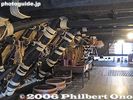
The bottom ends of these beams are pegged into a point (komajiri) resting on another cross beam. Wada House, Shirakawa-go
|
|

Gate to Takayama Jinya
|
|

Front of Yoshida Chiaki's home in Niigata (formerly Niitsu) which I visited in Nov. 2007. Yoshida Chiaki composed a song called "Hitsuji-gusa" (Water Lilies) whose melody was used for the song "Biwako Shuko no Uta" (Lake Biwa Rowi
|
|

Farmer's house
|
|

View of Ainokura from a hill
|
|

Entrance to Itoh Chube'e Memorial House
|
|

Gokasho was home to many Omi merchants who plied up and down Japan during the Edo Period to sell and trade their wares. They became quite successful selling medicines, lacquerware, sake, etc.Wall of former home of Omi merchant Tonomura Shigeru (1902-1961) (外村 繁邸).
|
|

Ceiling
|
|

Tea ceremony house
|
|

Entrance to Takayama Jinya. A Jinya was a regional government office during the Edo Period. The Tokugawa government dispatched magistrates to administer the region. About 60 jinya existed and only this one survives.
|
|
|
|
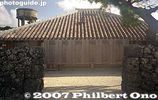
Okinawan house, Taketomi. Taketomi is a National Important Traditional Townscape Preservation District (重要伝統的建造物群保存地区).
|
|

Entrance to Itoh Chube'e Memorial House
|
|

Former home of Omi merchant Tonomura Shigeru (外村 繁邸). MapTonomura Shigeru (外村 繁), Tonomura Uhee (外村 宇兵衛), and Nakae Jungoro (中江 準五郎)
|
|

Kitamura house brought from Hadano, Kanagawa
|
|

Inside tea ceremony house
|
|

For 176 years or 25 generations, the building housed government administrators, accountants (rice tax collectors), and the police.
|
|

Front gate of Yoshida Chiaki's home
|
|

Bird's eye view of Ainokura 相倉展望台
|
|
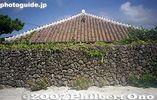
Okinawan house and rock wall, Taketomi
|
|

Front garden
|
|

Entrance to former home of Omi merchant Tonomura Shigeru (外村 繁邸). Gokasho is also a National Important Traditional Townscape Preservation District (重要伝統的建造物群保存地区).
|
|

Kitamura house
|
|
|

Inner garden. I met Yoshida Yuki (吉田ゆき), the niece of Yoshida Chiaki who showed me the house and a few materials. Flowers planted by Chiaki still grow in the garden.
|
|

Inside farmer's house
|
|
|
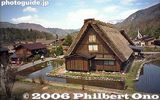
Shirakawa-go 白川郷
|
|

Front garden
|
|

Entrance to former home of Omi merchant Tonomura Shigeru.
|
|

Nihon Minkaen is an outdoor museum of traditional farm and merchant houses with thatched roofs. They have 25 homes from around Japan many were donated to the museum for preservation.
|
|

Magistrate's (governor) office 御役所
|
|

Yoshida Chiaki's room on the 2nd floor.
|
|

Another farmer's house
|
|

Ainokura
|
|

View of Administrator's office from the veranda
|
|

Maid's room
|
|

Living room of former home of Omi merchant Tonomura Shigeru.
|
|
|

Yoshida Chiaki's room on the 2nd floor. This is where he spent his final days while stricken with tuberculosis.
|
|
|
|
|

Inside entrance. The house was occupied by Itochu company founder Itoh Chube'e and his son, Chube'e II.
|
|
|
|
|

View from Yoshida Chiaki's room on the 2nd floor. Sometimes they receive local school children for tours of the house.
|
|
|

Shopkeeper's desk
|
|
|
|

Thatched roof
|
|

The main building was built in 1816.
|
|

Stairs from Yoshida Chiaki's room on the 2nd floor.
|
|

Ainokura
|
|

Shopkeeper's desk
|
|
|

Water nozzles aimed at the house. No smoking.
|
|
|
|

Original copy of the magazine "Ongaku-kai" (The Musical Japan) where Yoshida Chiaki's song "Hitsuji-gusa" was first published and made popular. Issued in Aug. 1915. 音楽界
|
|

Ainokura is smaller than Shirakawa-go, but still tourist-driven.
|
|

Shopkeeper's desk
|
|

Woman's hairdressing room.
|
|
|
|

Table of Contents of magazine "Ongaku-kai" (The Musical Japan) 音楽界. Many music-related articles.
|
|
|
|

Butsudan Buddhist altar in a butsuma (Buddhist altar room).
|
|

Room with Hina festival dolls and entrance to the Tonomura Shigeru Literature Museum. 雛祭りの雛人形
|
|
|
|
|

On the first page is Yoshida Chiaki's song "Hitsuji-gusa" (Water Lilies) which was acclaimed enough to be published here.
|
|
|
|

Tokonoma alcove and scroll. 奥の間
|
|

Hina festival dolls. 雛祭りの雛人形
|
|
|

On the first page is Yoshida Chiaki's song "Hitsuji-gusa" (Water Lilies). Although the melody is different, the lyrics are a direct translation of a childen's song called Water Lilies written by E.R.B. in the UK.
|
|
|
|
|

In 1998, the house was donated to a local foundation. In 2002, the house was opened to the public.
|
|

Hina festival dolls. 雛祭りの雛人形
|
|

Yamada house
|
|

Small book titled "A Garland of Flower-Poems" published in Japan. This was owned by Yoshida Chiaki and it includes the UK song "Water Lilies."
|
|
|
|

Exhibits of Itoh Chube'e II, the son of the founder Chube'e (1842-1903).
|
|

Entrance to the former residence of Omi merchant Fujii Hikoshiro (1876-1956) (藤井 彦四郎邸)
|
|

Tonomura Shigeru Literature Museum (Bungakukan). Shigeru had a passion for writing, so he entrusted the family business to his younger brother. 外村 繁文学館
|
|
|

Page where "Water Lilies" is printed in the book. It is very likely that Chiaki found the song in this book, and decided to make his Japanese version. His signature is on the back of the book.
|
|

Center of Ainokura and souvenir shop.
|
|

Bust of Itoh Chube'e II (1886-1973), his walking sticks, bag, and shoes.
|
|

Former residence of Omi merchant Fujii Hikoshiro (1876-1956) (藤井 彦四郎邸). Now a history museum.
|
|

Picture of Tonomura Shigeru in the Literature Museum (Bungakukan). 外村 繁文学館
|
|
|
|

Thatched roofs
|
|
|
|

Kitchen
|
|

Omi merchant statue.
|
|

Attic
|
|

Emukai house brought from Nanto, Toyama. In the gasshi-zukuri style with steep roof. Kawasaki Nihon Minkaen
|
|
|

Ainenji temple 相念寺
|
|

Rice storehouse
|
|
|
|

Omi merchant statue.
|
|

Hina festival dolls. 雛祭りの雛人形
|
|

Nihon Minkaen, Kawasaki, Kanagawa
|
|
|
|

These pictures were taken in the fall.
|
|

Yugao-tei Tea house 夕顔亭
|
|

Kitchen
|
|

Bust of Fujii Hikoshiro
|
|

Hina festival dolls. 雛祭りの雛人形
|
|

Inside Emukai house
|
|
|
|
|
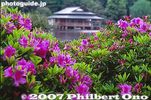
Azalea bushes and Ryotei teahouse
|
|

Stove 炊事場
|
|

Foyer of house 玄関
|
|

Hina festival dolls. 雛祭りの雛人形
|
|
|
|

Spare thatch, Ainokura
|
|
|
|

Western-style bath from the early 20th century. Very unusual at the time. 西洋風バスルーム
|
|

Entrance room
|
|

2nd floor balcony (Watch your head).
|
|
|
|
|

Center of Ainokura
|
|

Pine branches and azaleas
|
|

YouTube video of the song Hitsuji-gusa (Water Lilies) by a choir called Koai Gassho no Kai (小合合唱の会) performing at a memorial gathering on the anniversary of Chiaki’s death in Feb. 2013 at Chiaki’s birth home.Video uploaded by Ichii Yasuzo in Niigata.
|
|

Bathroom sink
|
|

Omi merchant display
|
|

2nd floor balcony
|
|
|
|

Magistrate's living quarters 居宅(嵐山の間)
|
|
|

Red and white azaleas
|
|

Built in 1935, a memorial for Itoh Chube'e in Kurenai Park. くれない園
|
|

Corridor to rooms and garden.
|
|

View from 2nd floor balcony
|
|
|
|
|
|

Ryotei teahouse 涼亭
|
|

Memorial marking Itoh Chobe'e's house, right near Itoh Chube'e's house. Chobe'e was Chube'e's older brother and co-founder of Marubeni Corporation.
|
|

2nd floor with more Hina dolls.
|
|
|
|

Monument in the center of Ainokura.
|
|

Another guest meeting room 客間
|
|

2nd floor room with Hina festival dolls. 雛祭りの雛人形
|
|

Nihon Minkaen, Kawasaki, Kanagawa
|
|
|
|
|

Main guest room 主客間
|
|

2nd floor room looking toward the balcony.
|
|

Toilet
|
|
|
|

Gassho Storehouse 合掌小屋造り
|
|

Main guest room
|
|

Hina festival dolls in alcove.
|
|

The museum park has 25 homes from around Japan many were donated to the museum for preservation. Near Mukogaoka-yuen Station on the Odakyu Line. Closed Mon. Admission 500 yen.
|
|
|
|
|

Main guest room
|
|

Hina festival dolls
|
|

Water mill
|
|

Restrooms
|
|

Bath area
|
|

Exterior view
|
|

2nd floor with Hina festival dolls
|
|

Inside water mill
|
|

Looks traditional on the outside, but modern on the inside.
|
|

Toilet
|
|

Exterior view
|
|

Hinamatsuri dolls
|
|

Hydrangea
|
|

Thatched roof and persimmon tree
|
|
|

Kitchen
|
|

Spacious garden outside Fujii Hikoshiro house
|
|
|
|
|

Former Ban family Omi merchant home which also served as a girls school and public library until 1997. Omi-Hachiman, Shiga. 旧伴家住宅Opened to the public in 2004 as a museum. 伴庄右衛門は江戸時代初期から活躍した八幡商人の一人で、屋号を扇屋といい、主に畳表・蚊帳を商い豪商となった。
|
|

Spacious garden outside Fujii Hikoshiro house (in background)
|
|

Kitchen area with dirt floor.
|
|
|

Pine tree in garden
|
|

Kitchen area
|
|

Large Hall (Dai-hiroma)
|
|

Fire hydrant
|
|

Spacious garden and Fujii Hikoshiro house
|
|

Furo bath wirth wooden barrel (heated by firewood)
|
|

Large Hall (Dai-hiroma) where ceremonies and meetings were held. It could also be partitioned into three rooms. Total area is 48 tatami mats. 大広間
|
|

Ainokura Folk Museum No. 1 南砺市相倉民俗館1号館Exhibits related to life in Ainokura and the gassho-zukuri houses.
|
|
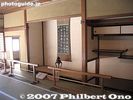
Tokonoma alcove
|
|
|

Changing room next to bath.
|
|

Ainokura Folk Museum No. 1
|
|
|
|

Western-style room
|
|

Path to next Omi merchant home.
|
|
|
|
|

Statue of Fujii Hikoshiro
|
|

Turn left there.
|
|
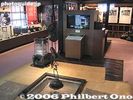
Inside Ainokura Folk Museum No. 1
|
|
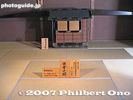
Palanquin
|
|

Former Nishikawa Residence (Kyu-Nishikawa-ke Jutaku), large Omi merchant home designated as an Imnportant Cultural Property. Omi-Hachiman, Shiga. 旧西川家住宅 国重要文化財
|
|

Old photos of Omi merchants
|
|
|

Inside Ainokura Folk Museum No. 1
|
|
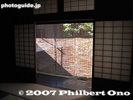
Bamboo screen
|
|

Old photos of Omi merchants carrying their trademark "tenbin" pole.
|
|

Former home of Omi merchant Tonomura Uhee (1777-1820) (外村 宇兵衛邸).
|
|

Inside Ainokura Folk Museum No. 1
|
|
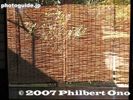
Bamboo screen
|
|

Western-style room
|
|

Entrance to former home of Omi merchant Tonomura Uhee.
|
|

Roof peg
|
|

Inside Nishikawa residence. Omi-Hachiman, Shiga. 国重要文化財畳表や蚊帳を扱っていた江戸時代の豪商・西川利右衛門の旧宅
|
|

Record books
|
|

Inside former home of Omi merchant Tonomura Uhee. 玄関
|
|

Old minka house on Mt. Mitake, Tokyo
|
|

Torture room 吟味所・御白洲
|
|
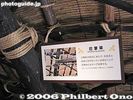
Gassho hari
|
|

Nishikawa Villa
|
|
| 1496 files on 6 page(s) |
1 |
 |
 |
 |
|